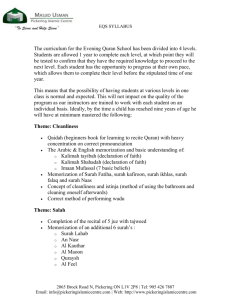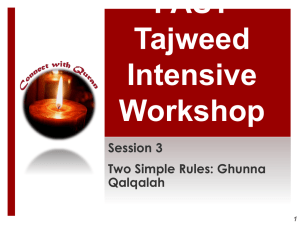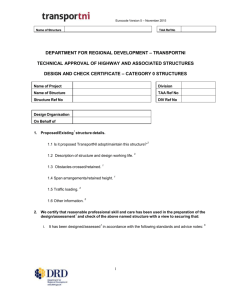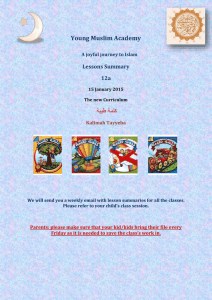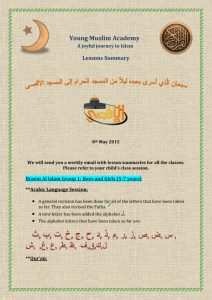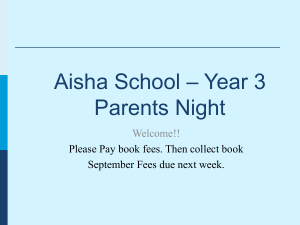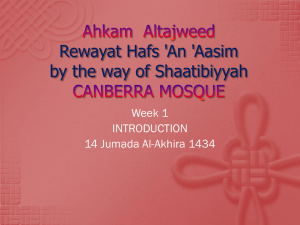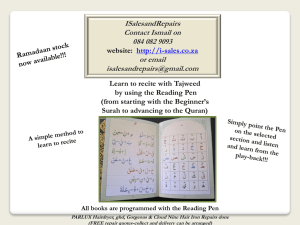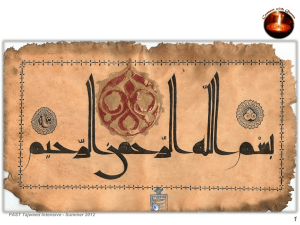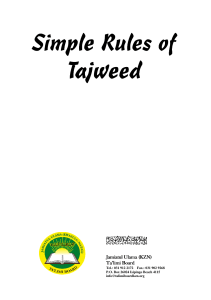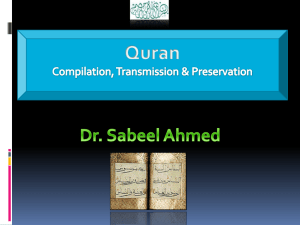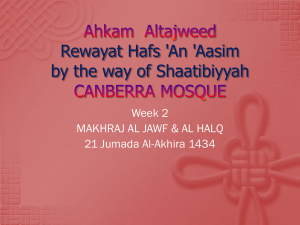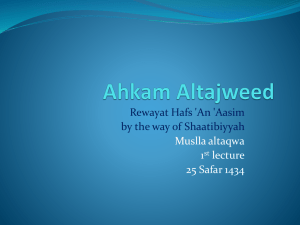Tajweed PPT - Universal School of Buffalo
advertisement
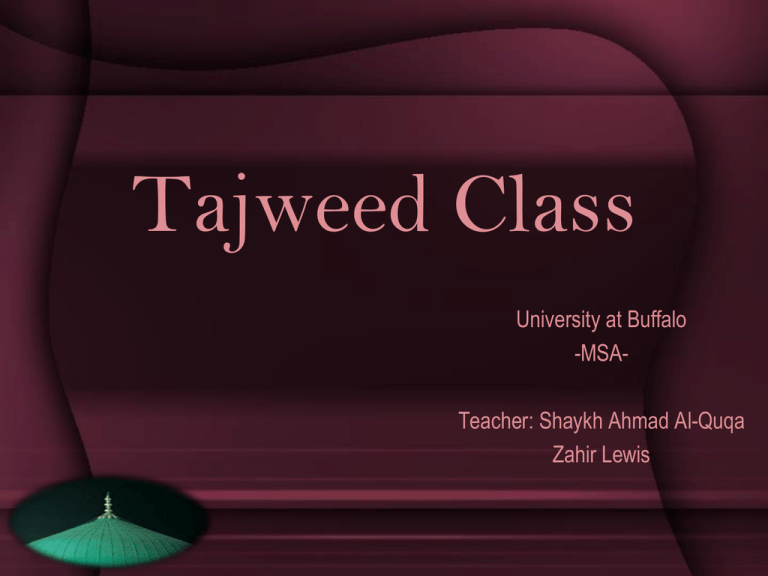
Tajweed Class University at Buffalo -MSATeacher: Shaykh Ahmad Al-Quqa Zahir Lewis What is Tajweed? • Tajweed means to recite every letter correctly, i.e. from its proper origin of pronunciation coupled with its stipulated attributes. • Example Haa and Haa • Do you use your mouth or throat for these letters? Why Attend This Class? • To recite the Book of Allah Most High with the proper articulation and pronunciation. • To recite the Book of Allah Most High as it was revealed. • To recite Quran like our Prophet . Waste of time?!? • “Brother, what is the point of memorizing and reading Quran if you don’t even understand the meaning?”….. Reply: Are you serious?! • Each letter is a Nur. • Hadiths on virtues of Quran. • 1st step The Tajweed Class of the Sahabah • Our Beloved Prophet was the teacher of the Sahabah. • No “Tajweed” classes back then. • Tajweed in modern times. Before Alif, Baa, Taa • Before one seeks out to learn a single letter from The Quran, one must first establish his/her proper intention for doing so. • Check ourselves: what is our intention for learning Quran. Because Allah gifted us with a nice voice, to lead prayers, etc. The Next Step • After our intention is pure, we must go to the next step. • Aadaab al Quran: Proper Etiquettes we must have for The Book of Allah Most High. • In order for us to attain the maximum benefit from Allah’s Book, we will have to have true respect for It internally as well as externally Some Aadaab • Wudhu. • Sitting at a clean place/Clean clothes. • Refraining from eating, drinking, talking, etc while reading. • Refraining from holding the Mushaf with the left hand. • Putting the Mushaf on a raised place. • Never putting It on the floor, even Masjid al Haraam. • Avoid slouching while reading. Finally…. • Please bare with me. There is no ending point in Quran. We can always increase our knowledge in this field and keep on learning new things each time! • With this in mind, lets review our letters and make sure we’re pronouncing them correctly. This is the foundational step in learning Quran. • Our duty: Continuous studies. 1st Lesson: Arabic Alphabet Lesson 2: Surah Al Fatiha • Common errors in Surah Al Fatiha: – – – – – – – – – – – Incomplete dhamma or kasra Merging of 2 letters i.e. A’udhu Taa instead of Taa Seen instead of Sad Switching Haa and Haa Switching up the heavy and light aspects of a letter i.e. noon with kasra “na” “naw” Kaaf Taa “An’amta”/”Ana’amta” Daad Madd Lesson 3: Surah An Nas DON’T FORGET **IMPLEMENT YOUR TAJWEED FROM AL FATIHA!** • 1st Rule: Harf Ghunna Mushaddad- letters of ghunna that have shaddah – Occurs when noon and meem have shaddah. – Hold for 2 counts. – Ghunnah- Nasalization sound that must come from nose. Lesson 4: Surah Al Falaq • 2nd Rule: Al Ikhfaa Haqeeqi- hiding or concealment – Occurs when there is a noon saakin or tanween followed by 15 letters: – Taa Thaa Jeem…. – Hold for 2 counts – Ghunna – Can occur on 1 or 2 words i.e. “antum”, “in kuntum” – Light letters: The Ikhfaa will be said with a light sound: Taa, Thaa, Daal, Dhaal, Jeem, Zaa, Seen, Sheen, Faa, Kaaf – Heavy Letters: The Ikhfaa will be said with a heavy sound: Saad, Daad, Taa, Thaa, Qaaf Lesson 5: Surah Al Ikhlaas/Lahab(Masad) • 3rd Rule: Qalqalah- echo or bouncing sound. Occurs with the letters: Qaaf, Taa, Baa, Jeem, & Daal – 1. Qalqalah Sughraa- end of word, in middle of ayah – 2. Qalqalah Wustaa- middle of word whether at beginning or middle – 3. Qalqalah Kubraa- end of ayah Lesson 6: Review Surah An Nasr • Apply the rules you learned to Surah An Nasr. Al Mudood • Al Madd- Lenghthing of the sound with the letters of the Madd letters -Letters of madd are: Alif, Yaa, and Waaw – Alif saakinah preceded by fatha – Yaa saakinah precedd by kasra – Waaw saakinah preceded by dhamma Al Leen • Waaw preceded by fatha • Yaa preceded by fatha
